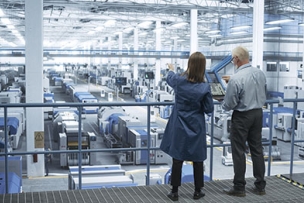Find out the major changes in OSHA's final rule to update general industry walking-working surfaces and fall protection standards.
Video Highlights
The final rule from OSHA on walking and working surfaces is in. The rule covers the general industry workplace, including floors, stairs, ladders, ramps, elevated walkways and scaffolds. The goal is to reduce slips, trips, falls, injuries and fatalities caused by walking-working surface hazards.
For a full transcript of the video, click here
Find out the major changes in OSHA's final rule to update general industry walking-working surfaces and fall protection standards.
Video Transcript
In November of 2016, OSHA published its final rule on walking and working surfaces. The new rule applies to all general industry workplaces, covering surfaces like floors, stairs, ladders, ramps, scaffolds, and elevated walkways. From warehousing, to retail and more, the goal is to reduce slips, trips, and falls as well as other injuries and fatalities associated with walking working surface actions.
The final rule increases consistency between the general industry and construction standards, making it easier for employers who conduct operations in both industry sectors. The final rule becomes effective January 17, 2017 and compliance dates vary to give employers time to understand the standards and upgrade systems as part of their normal business cycle to reduce costs.
So, what are the major changes? Instead of mandating guardrails, employers can choose the fall protection system best for their workplace situation. Scaffold standards for general industry now comply with the standards for construction. Fixed ladder cages and wells will be phased out and replaced with ladder safety systems or personal fall arrest systems. Over a 20-year period, outdoor advertising qualified climbers will need fall protection, and fixed ladders over 24 ft. will require a ladder safety system or personal fall arrest system. Rope descent systems are prohibited for heights greater than 300 ft. above grade unless other solutions are not feasible.
Additionally, employers need proof that permanent anchorage is used with a rope descent system have been inspected, tested, certified, and maintained as capable of supporting at least 5,000 lbs. per employee attached. As in OSHA’s construction standard, personal fall protection systems can be used but cannot include body belts, and they have new performance, inspection, use, and maintenance requirements.
Employers must inspect walking working surfaces regularly and correct and guard against hazardous conditions. Fall protection d-rings, snap hooks, and carabiners must be proof-tested for tensile loads of 3,600 lbs. And date strengths must also be designed to withstand at least 3,600 lbs. aligning with ANSI ASSE z359.12.
Provisions for controlling fall hazards on low-sloped roofs have been clarified, fall protection options are provided for distances of less than 6 ft. from edge, 6 ft. up to 15 ft., and 15 ft. or more. Finally, if workers use personal fall protection or work in other high-hazard situations, they must be trained and re-trained in a manner they understand.
To learn more about the final rule on walking working surfaces, visit OSHA's website or contact your 3M technical specialist.
Brought To You By

Products that work as hard as you do. From the most basic to the most specialized needs, 3M offers the health and safety protection you and your workers need most, so everyone can perform at their best. We strive to deliver comfortable, well-designed personal protective equipment (PPE) that offers your workers the most effective protection available.
Related Articles
With the introduction of a new industrial bump cap standard, safety professionals have a new tool to address a critical gap in workplace head protection.
Proper illumination in manufacturing facilities keeps workers safe and productive, and the company in compliance. Here’s what you need to know about industrial lighting standards.
To protect construction workers from severe impacts, falling or flying objects, or electrical shock, OSHA requires employers to provide personal protective equipment (PPE) to their employees, such as hard hats.




Talk to Us!
Leave a reply
Your email address will not be published. Required fields are marked *